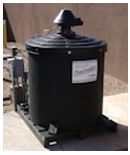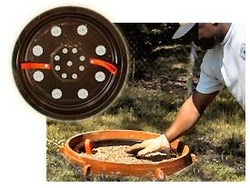Odor Control

HIGH H2S - H2S Converting/Polishing Dry Air Scrubbers Series
A two stage dry scrubber for very high H2S concentrations: STAGE ONE – PERSNICKETY© H2S CONVERTING© MEDIA Converting technology uses a patented polymeric amine, formulated for maximum removal of H2S and volatile mercaptans. The combination of multiple amine sites and organophilic properties allows for fast, efficient removal of these problematic compounds. This chemistry reacts with H2S and mercaptans to form water-soluble and non-volatile poly sulfides that are readily biodegradable. In simple words, gaseous H2S is turned into a stable liquid polymer. All of our scrubber systems are designed to achieve a H2S reduction of 99% through the Stage 1 media bed. STAGE TWO – PERSNICKETY© POLISHING© MEDIA Activated carbon does a very efficient job of scrubbing low levels of H2S and other malodors. 99% of the H2S and the majority of volatile mercaptans, organic amines and organic sulfurs are removed in the converting bed. With that being accomplished, the polishing bed will easily remove the remaining low level malodors. This results in complete and economic odor control. 
LOW H2S - ClO2 Oxidizing/Polishing Dry Air Scrubbers
A two stage dry scrubber for lower H2S concentrations: STAGE ONE – A Chlorine Dioxide Layer This layer releases chlorine dioxide (ClO2) when contacted by H2S molecules. Reactions are instantaneous, and produce inorganic sulfate. Simply stated, salt drops out. Chlorine dioxide is an extremely powerful oxidizing agent. Because it reacts selectively and primarily only with the most offensive odor- producing compounds, it will remain intact longer than chlorine, sodium hypochlorite, peroxide and potassium permanganate. Since unwanted reactions do not occur, power is not wasted and service life is extended. STAGE TWO – A Polishing Layer This layer uses Countervailant® technology. Malodorous molecules contain one or more chemically reactive groups called osmophores. Polishing reactions with these groups are varied, but are most commonly electrostatic and/or polymeric. The worst odors have the strongest negative charges, which are drawn to the positive charges of the Countervailant® chemistry. The union either facilitates a chemical reaction or creates a large molecule of low vapor pressure. A homo–polymer lattice forms around reacted or absorbed molecules and osmophoric activity ceases. 
Odor Control Manhole Inserts -Technology designed for the control of hydrogen sulfide, mercaptans and other malodorous compounds found in sewer gases.
Nearly all municipalities suffer with odor problems from manholes. The main culprit is hydrogen sulfide (H2S), but other malodorous compounds are present, as well. The problem has not been easy. Treating flow is very expensive. Systems for treating air usually require electrical power and/or clean water. Sealing covers moves the problem down the line or through the vents of neighboring homes and businesses. These complications are all solved with PEACEMAKER odor control manhole inserts. Odor control manhole inserts provide generous venting through PERSNICKETY® H2S Converting/Oxidizing/Polishing Media using a patented polymeric amine, formulated for maximum removal of H2S and volatile mercaptans. The combination of multiple amine sites and organophilic properties allows for fast, efficient removal of these problematic compounds. This chemistry reacts with H2S and mercaptans to form water-soluble and non-volatile poly sulfides that are readily biodegradable. In simple words, gaseous H2S is turned into a stable liquid polymer. SUMMARY OF ADVANTAGES
|
